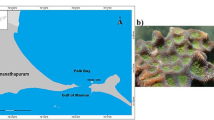Abstract
A Gram-stain-negative, strictly aerobic, non-flagellated, rod-shaped bacterium, designated GSB7T, was isolated from seawater collected at the Yellow Sea coast of South Korea. Catalase and oxidase activities were positive. Growth occurred at pH 6.0–9.0 (optimum pH 7.0), 10–40 °C (optimum 30 °C) and with 0–8% NaCl (optimum 1–2%). Phylogenetic analysis based on 16S rRNA gene sequences revealed that strain GSB7T belonged to the genus Marivivens, showing the sequence similarities of 96.3, 96.1, and 96.0% with Marivivens niveibacter HSLHS2T, Limimaricola hongkongensis DSM17492T, and Marivivens donghaensis AM-4T, respectively. The respiratory quinone was ubiquinone-10 and the major fatty acids were summed feature 8 (C18:1 ω7c and/or C18:1 ω6c), C18:1 ω7c 11-methyl, C16:0 and C10:0 3-OH. The polar lipids comprised phosphatidylglycerol, diphosphatidylglycerol, one unidentified aminolipid, and five unidentified lipids. The DNA G + C content calculated from the whole-genome sequence was 60.6 mol%. On the basis of phenotypic, chemotaxonomic and genotypic characteristics presented in this study, strain GSB7T is suggested to represent a novel species of the genus Marivivens, for which the name Marivivens aquimaris sp. nov. is proposed. The type strain is GSB7T (= KCTC 82026T = JCM 34042T).

Similar content being viewed by others
Abbreviations
- MA:
-
Marine agar
- MB:
-
Marine broth
- KCTC:
-
Korean Collection for Type Cultures
- JCM:
-
Japan Collection of Microorganisms
- NJ:
-
Neighbor-joining
- ML:
-
Maximum-likelihood
- MP:
-
Maximum-parsimony
- ANI:
-
Average nucleotide identity
- dDDH:
-
Digital DNA–DNA hybridization
- UBCG:
-
Up-to-date bacterial core gene set
- NA:
-
Nutrient agar
- TSA:
-
Tryptic soy agar
References
Barrow GI, Feltham RKA (2004) Cowan and steel’s manual for the identification of medical bacteria, 3rd edn. Cambridge University Press
Chin C-S, Alexander DH, Marks P, Klammer AA, Drake J, Heiner C, Clum A, Copeland A, Huddleston J, Eichler EE, Turner SW, Korlach J (2013) Nonhybrid, finished microbial genome assemblies from long-read SMRT sequencing data. Nat Methods 10:563–569
Chun JS, Oren A, Ventosa A, Christensen H, Arahal DR, da Costa MS, Rooney AP, Yi H, Xu X-W, De Meyer S, Trujillo ME (2018) Proposed minimal standards for the use of genome data for the taxonomy of prokaryotes. Int J Syst Evol Microbiol 68:461–466
Collins MD (1985) Isoprenoid quinone analysis in classification and identification. In: Goodfellow M, Minnikin DE (eds) Chemical methods in bacterial systematics. Academic Press, London, pp 267–287
Collins MD, Jones D (1980) Lipids in the classification and identification of coryneform bacteria containing peptidoglycans based on 2,4-diaminobutyric acid. J Appl Bacteriol 48:459–470
Felsenstein J (1981) Evolutionary trees from DNA sequences: a maximum likelihood approach. J Mol Evol 17:368–376
Felsenstein J (1985) Confidence limits on phylogenies: an approach using the bootstrap. Evolution 39:783–791
Fitch WM (1971) Toward defining the course of evolution: minimum change for a specific tree topology. Syst Biol 20:406–416
Gomori G (1955) Preparation of buffers for use in enzyme studies. Methods Enzymol 1:138–146
Hu D, Wang L, Lai Q, Sun F, Shao Z (2018) Marivivens niveibacter sp. nov., isolated from the seawater of tropical mangrove. Int J Syst Evol Microbiol 68:570–574
Huerta-Cepas J, Szklarczyk D, Forslund K, Cook H, Heller D, Walter MC, Rattei T, Mende DR, Sunagawa S, Kuhn M, Jensen LJ, von Mering C, Bork P (2016) eggNOG 4.5: a hierarchical orthology framework with improved functional annotations for eukaryotic, prokaryotic and viral sequences. Nucleic Acids Res 44:D286–D293
Kimura M (1980) A simple method for estimating evolutionary rates of base substitutions through comparative studies of nucleotide sequences. J Mol Evol 16:111–120
Kumar S, Stecher G, Li M, Knyaz C, Tamura K (2018) Mega x: molecular evolutionary genetics analysis across computing platforms. Mol Biol Evol 35:1547–1549
McCarthy A (2010) Third generation DNA sequencing: Pacific biosciences’ single molecule real time technology. Chem Biol 17:675–676
Meier-Kolthoff JP, Auch AF, Klenk H-P, Göker M (2013) Genome sequence-based species delimitation with confidence intervals and improved distance functions. BMC Bioinformatics 14:60
Minnikin DE, O’Donnell AG, Goodfellow M, Alderson G, Athalye M, Schaal A, Parlett JH (1984) An integrated procedure for the extraction of bacterial isoprenoid quinones and polar lipids. J Microbiol Methods 2:233–241
Na S-I, Kim YO, Yoon S-H, Ha S-M, Baek I, Chun J (2018) UBCG: Up-to-date bacterial core gene set and pipeline for phylogenomic tree reconstruction. J Microbiol 56:280–285
Park S, Kim S, Jung YT, Yoon JH (2016) Marivivens donghaensis gen. nov., sp. nov., isolated from seawater. Int J Syst Evol Microbiol 66:666–672
Saitou N, Nei M (1987) The neighbor-joining method: a new method for reconstructing phylogenetic trees. Mol Biol Evol 4:406–425
Sasser M (1990) Identification of bacteria by gas chromatography of cellular fatty acids, MIDI Technical Note 101. MIDI Inc, Netwark, DE
Stackebrandt E, Ebers J (2006) Taxonomic parameters revisited: tarnished gold standards. Microbiol Today 33:152–155
Yoon SH, Ha SM, Kwon S, Lim J, Kim Y, Seo H, Chun J (2017a) Introducing ezbiocloud: A taxonomically united database of 16S rRNA gene sequences and whole-genome assemblies. Int J Syst Evol Microbiol 67:1613–1617
Yoon SH, Ha SM, Lim J, Kwon S, Chun J (2017b) A large-scale evaluation of algorithms to calculate average nucleotide identity. Antonie Van Leeuwenhoek 110:1281–1286
Acknowledgements
This study was supported by the Technology Development Program to solve climate changes (Systems Metabolic Engineering for Biorefineries) from the Ministry of Science and ICT through the National Research Foundation (NRF) of Korea and a basic research grant from the Korea Research Institute of Bioscience and Biotechnology (KRIBB).
Author information
Authors and Affiliations
Corresponding authors
Ethics declarations
Conflict of interest
The authors declare that there are no conflicts of interest.
Additional information
Communicated by Erko Stackebrandt.
Publisher's Note
Springer Nature remains neutral with regard to jurisdictional claims in published maps and institutional affiliations.
Supplementary Information
Below is the link to the electronic supplementary material.
Rights and permissions
About this article
Cite this article
Kim, J.A., Lee, B., Kang, J.Y. et al. Marivivens aquimaris sp. nov., isolated from seawater. Arch Microbiol 203, 3229–3234 (2021). https://doi.org/10.1007/s00203-021-02305-7
Received:
Revised:
Accepted:
Published:
Issue Date:
DOI: https://doi.org/10.1007/s00203-021-02305-7




